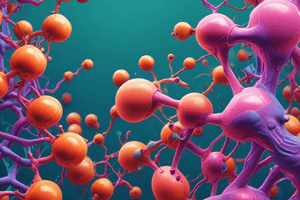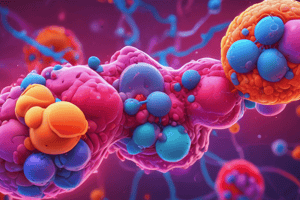Podcast
Questions and Answers
What does the term 'hormone' mean, based on its Greek origin?
What does the term 'hormone' mean, based on its Greek origin?
- To protect or defend
- To energize or stimulate
- To excite or arouse (correct)
- To calm or relax
How do hormones communicate their effects to target cells?
How do hormones communicate their effects to target cells?
- By direct contact with target cells
- By interacting with neighboring cells
- By general diffusion in the bloodstream
- By specific receptors on target cells (correct)
Which hormone is essential in both development and aspects of homeostasis and metabolism?
Which hormone is essential in both development and aspects of homeostasis and metabolism?
- Cortisol
- Thyroid hormone (correct)
- Insulin
- Glucagon
In controlling blood glucose, which hormones are involved along with insulin?
In controlling blood glucose, which hormones are involved along with insulin?
Which of the following is NOT a category of functions performed by hormones?
Which of the following is NOT a category of functions performed by hormones?
What aspect of hormones allows them to affect multiple functions within the body?
What aspect of hormones allows them to affect multiple functions within the body?
What is the key difference between exocrine and endocrine glands?
What is the key difference between exocrine and endocrine glands?
What defines a paracrine mechanism of chemical signaling?
What defines a paracrine mechanism of chemical signaling?
What is the first step in hormone action?
What is the first step in hormone action?
Which type of signaling involves a chemical acting on the same cell that released it?
Which type of signaling involves a chemical acting on the same cell that released it?
What are hormone receptors?
What are hormone receptors?
Which class of hormones is typically synthesized from cholesterol?
Which class of hormones is typically synthesized from cholesterol?
What defines classical endocrine and neuroendocrine signaling mechanisms?
What defines classical endocrine and neuroendocrine signaling mechanisms?
What is the largest group of hormones based on chemical type?
What is the largest group of hormones based on chemical type?
Where are the receptors located for lipophilic (Hydrophobic) hormones of Group I?
Where are the receptors located for lipophilic (Hydrophobic) hormones of Group I?
Which of the following is NOT a class of hormones based on chemical nature?
Which of the following is NOT a class of hormones based on chemical nature?
Which hormone can pass through the lipophilic plasma membrane to interact with intracellular receptors?
Which hormone can pass through the lipophilic plasma membrane to interact with intracellular receptors?
Which group of hormones is characterized by being large protein molecules with carbohydrate side chains?
Which group of hormones is characterized by being large protein molecules with carbohydrate side chains?
Flashcards
Hormone (origin)
Hormone (origin)
From Greek, hormone means 'to excite or arouse'.
Hormone Communication
Hormone Communication
Hormones bind to specific receptors on target cells, triggering a response.
Thyroid Hormone
Thyroid Hormone
Thyroid hormone is crucial for development, homeostasis, and metabolism.
Blood Glucose Hormones
Blood Glucose Hormones
Signup and view all the flashcards
Hormone Functions
Hormone Functions
Signup and view all the flashcards
Hormone Specificity
Hormone Specificity
Signup and view all the flashcards
Endocrine vs. Exocrine
Endocrine vs. Exocrine
Signup and view all the flashcards
Paracrine Signaling
Paracrine Signaling
Signup and view all the flashcards
First Step in Action
First Step in Action
Signup and view all the flashcards
Autocrine Signaling
Autocrine Signaling
Signup and view all the flashcards
Hormone Receptors
Hormone Receptors
Signup and view all the flashcards
Steroid Hormones
Steroid Hormones
Signup and view all the flashcards
Endocrine Signaling
Endocrine Signaling
Signup and view all the flashcards
Largest Hormone Group
Largest Hormone Group
Signup and view all the flashcards
Lipophilic Hormone Receptors
Lipophilic Hormone Receptors
Signup and view all the flashcards
Hormone Classes
Hormone Classes
Signup and view all the flashcards
Thyroxine Action
Thyroxine Action
Signup and view all the flashcards
Glycoprotein Hormones
Glycoprotein Hormones
Signup and view all the flashcards




